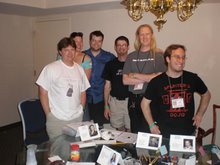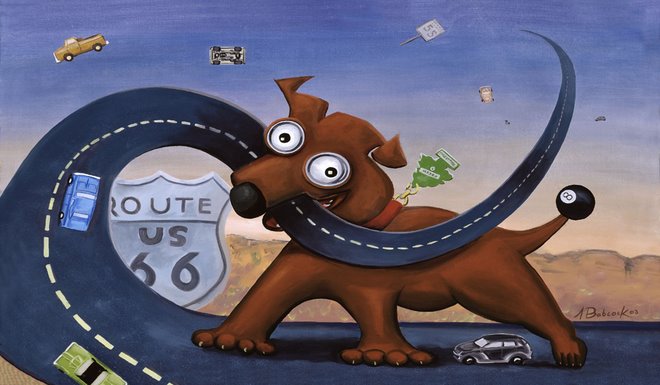At the March Endgame MiniCon I played in games of Spirit of the Century and Don't Rest Your Head. Each of these games started with character creation. I did the same thing in my InSpectres game earlier, but got lessons from these games about how to do it much better.
I usually avoid any Convention game that has the following in the description, "Characters created together at start". I don't want to waste valuable game time creating characters. I spend hours and hours preparing interesting characters for convention games. At DunDraCon one of the bad games I played in was a D20 Modern game in which we all had to create characters at the beginning. This took 1.5 hrs! Now the game was scheduled for 8 hours. We ended up 'playing' for 9. Hmmm... InSpectres characters can be created in about 15 minutes and it's part of the fun. I gave the Players a brief description of some cases their characters had worked and moved ahead. It worked, but the following method worked better.
Both GM's used a Q&A process to create the characters and more importantly - establish the relationships between the characters. These are only 4-hr long games, so tick-tock on the session from the get. The 1st game was Shadowrun (using Spirit of the Century) and the GM (Brian Isikoff) flat out told us it was a revenge story. Our group had been hosed on a job 10 years earlier and now that the last of us was getting out of jail, we were after some payback - if we could figure out who screwed us.
Brian asked which one of us was the one getting out of jail. Someone volunteered. Brian asked their position in the group. They picked a job.
Who had been the leader of the group? Someone volunteered. Brian asked how he felt about the job going south. The group leader decided that he felt personally responsible for it going wrong.
Brian nodded and asked who had set up the job. I found myself volunteering. It came to me that it was a contact provided by someone I'd worked with before. I'd brought the job to the crew. How did I feel about setting up a hose job? I needed to regain respect from the crew. What was my job? Driver and repair tech, I decided.
More nodding from Brian. He asked if anyone distrusted my character for setting up the job. Someone volunteered...
And so it went until we'd established the characters and how they all felt about the incident 10 years back. We even decided if the mistrust was likely to break out into an internal gunfight, or if people were just leery of each other. The characters were loosely created in a few minutes and we were off.
With that, a simple revenge story turned into a great roleplaying experience. It was more about the character relationships than the story and everyone got into it because we understood how our characters felt about the 'situation' and each other. Brian incorporated some of the aspects of our characters into the story and the resolution had not just guns-ablazin' payback, but emotional impact. Dang!
Ryan Macklin started the Don't Rest Your Head game in a similar manner. We played 1st grade kids in the same class (I don't like games in which adults play kids). The game uses 5 questions as the primary tool in character creation. Ryan expanded this to 10, adding questions specific to the adventure. Questions like "What do the kids in your class think of you?" and "What is home life really like?" got us into the characters and their relationships. He encouraged us to start with stereotypes, the Smart Kid, the Cute Kid, the New Kid, the Fat Kid, etc. and build on that base.
We bounced around the table from Player to Player getting an idea of the what the characters thought of each other and Ryan encouraged us to twist the character concepts as far as we liked. One of the SF group, Freak Master Gil Travizo, was also in this game. He played New Kid, who seemed to have a call girl for a mom. I played Wealthy Stuck-up Kid who had no home life, a completely controlled schedule and wished his parents saw him as a person. Military Kid had a 'more loved' brother serving in Iraq. Cute Kid had a mother who always called him a fat pig and put him on a new wierd diet every few weeks. He just reeeealy wanted to eat a pizza, like other kids.
What did we think of these other kids? We got down and dirty, like only kids can. Their lunch smelled funny, they had cheap toys, they didn't have a personal chef, their clothes didn't fit right, but at least they talked to New Kid, they know all about guns - which is kinda cool.
In short order we had not only created interesting characters, but as in Brian's game established the relationships between them. When we got into the game it was a breeze to drop into character and play off of each other.
Ryan did another cool thing which was to allow us to create the villain we faced. We drew from our characters' worst nightmares and it didn't take long until we had a truly creeping bad-guy. In fact, I described the villain to someone (a non-horror fan). It actually gave them nightmares!!!
I play tested my Terror at 6666 Feet game with the SF group. The characters are on a group vacation together and the tour guide asks them all to "tell us a bit about yourself". I wasn't sure about this and I think that it added extra time to the game. I'd planned to cut it for the convention session, but since the MiniCon experiences, have decided to keep it as it sets up relationships between the characters.
Now I'm looking at using this tool for other games as well. This would be very interesting in a Call of Cthulhu Game. It so won't work in Paranoia though... Thanks Brian & Ryan!!!
Subscribe to:
Post Comments (Atom)



No comments:
Post a Comment